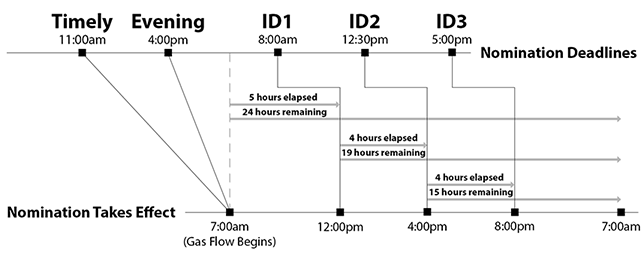"PG&E" refers to Pacific Gas and Electric Company, a subsidiary of PG&E Corporation. © 2025 Pacific Gas and Electric Company. All rights reserved.
If you wish to reduce a scheduled nomination for the Intraday 1 (ID1), Intraday 2 (ID2), or Intraday 3 (ID3) nomination cycles, the volume to which that nomination can be reduced (the "floor" volume) will be calculated according to elapsed proration. Essentially, this calculation determines what portion of your nomination is considered to have already flowed by the time the next cycle’s gas will flow (the cycle for which you are attempting to reduce the nomination).
Nominations can be reduced to zero for a gas flow day up to the Evening cycle because no gas will have flowed for that gas day by the time the Timely and Evening Cycles’ deadlines have passed. That is, the EPSQ calculation is not necessary for these cycles because gas for the Timely and Evening cycles won’t flow until 7:00 am the following day.
A customer can view the EPSQ for a particular nomination from the Nominations menu in INSIDEtracc. From the Nominations menu, the user should click on the Query Nomination Details screen. Clicking on the Action icon next to a particular nomination will display the Replace Volume or Rank screen. The EPSQ volume can be seen here. If the customer attempts to reduce a nom below the EPSQ floor, they will receive a message at the top of the page indicating that their action is not allowed.
EPSQ is calculated on a nomination by nomination basis.
The following elapsed pro rata formulas will be used to calculate the floor volume for ID1, ID2, and ID3 nomination cycles in INSIDEtracc:
ID1 EPSQ:
After Evening Schedule, EPSQ is calculated for the next cycle (ID1). From the start of gas flow for Evening (7:00 am) to the start of gas flow for ID1 (noon), 5 hours will have elapsed. Because Timely and Evening gas won’t flow until 7:00 am the following day), there are still 24 hours for gas to flow.
ID1 EPSQ = Evening Scheduled Volume x 5/24
If Evening Scheduled Volume = 12,000 Dth, the EPSQ for ID1 will be 2,500 Dth. In other words, the customer would not be allowed to reduce their nom for the ID1 cycle below the floor of 2,500 Dth.
ID2 EPSQ:
After ID1 Schedule, EPSQ is calculated for the next cycle (ID2). From the start of gas flow for ID1 (noon) to start of gas flow for ID2 (4:00 pm), 4 hours will have elapsed.
Because ID1 gas starts flowing at 12:00 noon, there are 19 hours left in the gas day for gas to flow.
ID2 EPSQ = ID1 EPSQ Volume + [(ID1 Scheduled Volume – ID1 EPSQ Volume) x 4/19]
If the ID1 scheduled volume = 12,000 Dth, the EPSQ for ID2 will be 2,500 Dth + [(12,000 Dth – 2,500 Dth) x 4/19] = 4,500 Dth.
In other words, the customer would not be allowed to reduce their nom for the ID2 cycle below the floor of 4,500 Dth.
ID3 EPSQ:
After ID2 Schedule, EPSQ is calculated for the next cycle (ID3).
From the start of gas flow for ID2 (4:00 pm) to start of gas flow for ID3 (8:00 pm), 4 hours will have elapsed.
Because ID2 gas starts flowing at 4:00 pm, there are 15 hours left in the gas day.
ID3 EPSQ = ID2 EPSQ Volume + [(ID2 Scheduled Volume – ID2 EPSQ Volume) x 4/15]
If the ID2 scheduled volume = 15,000 Dth, the EPSQ for ID3 will be 4,500 Dth + [(15,000 Dth – 4,500 Dth) x 4/15] = 7,300 Dth.
In other words, the customer would not be allowed to reduce their nom for the ID3 cycle below the floor of 7,300 Dth.
The following diagram compares the scheduling timeline to the actual physical flow of gas. All times are Pacific time.

If you have any questions about these pro rata nominations, please contact the CGT Scheduling Team (1.800.343.4743) or your CGT Account Manager.